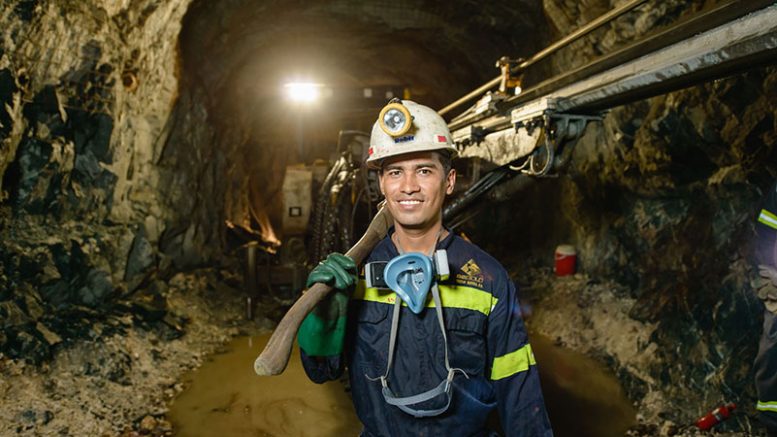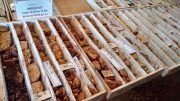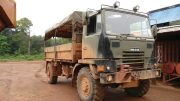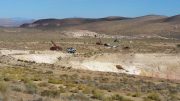B2Gold (TSX: BTO; NYSE-AM: BTG) was created as a junior exploration company in 2007, and since then it has grown to become an intermediate gold producer, with five mines in four countries.
Last year production reached 953,504 oz. gold — a 51% jump over 2017 — sending revenues nearly doubling year-on-year to US$1.2 billion, and cash flow almost tripling to US$451 million.
That war chest helped B2Gold slash debt US$220 million, and still end the year with US$103 million in cash and equivalents.
This year management has carved out a US$43-million exploration budget.
The funds will be used for exploration around the company’s mines in Mali, Namibia, the Philippines and Nicaragua, but the lion’s share — US$15 million (40% of the total) — will be spent in Mali at its Fekola mine, now in its second full year of commercial production, and where B2Gold reported a substantial increase in resources late last year.
The new resource for the West African mine is contiguous to the north of the current Fekola reserve pit boundary, and extends the resource pit boundary 1.2 km north.
“We continued to drill during the three years we were building the mine, so we could announce a much bigger resource,” Clive Johnson, B2Gold’s president and CEO, tells The Northern Miner.
 Fekola project location map. Credit: B2Gold.
Fekola project location map. Credit: B2Gold.
This year, B2Gold plans to continue to convert inferred resources to the indicated category, drilling northwest of the deposit.
The company has already started a 25,000-metre infill drill program, and along with earlier drilling, this will help calculate probable reserves for the extended Fekola deposit.
Fekola has 92.81 million tonnes grading 1.92 grams gold per tonne for 5.73 million contained oz. gold, and 26.50 million inferred tonnes averaging 1.61 grams gold for 1.37 million oz. gold. The resource was reported within a pit shell using a US$1,400 per oz. gold price.
At US$1,250 per oz. gold, Fekola contains 90.67 million indicated tonnes grading 1.94 grams gold for 5.67 million oz. gold, and 16.62 million inferred tonnes averaging 1.58 grams gold for 844,000 oz. gold.
The company recently completed a study evaluating whether to expand the mine and mill from the base case throughput of 6 million tonnes per year to 7.5 million tonnes per year, at a capital cost of US$50 million. The board will make a decision soon. Johnson calls it “a no-brainer.”
B2Gold’s exploration budget in southwestern Mali includes US$3 million for reverse-circulation and diamond drilling on its Anaconda zones, 20 km from Fekola. The drilling at Anaconda, which the company also refers to as “the Snakes,” will focus on mineralized sulphide targets below the shallow oxidized saprolite zones, where previous drilling intersected decent gold grades.
In June 2017, the company reported an inferred resource for Anaconda’s saprolite mineralization of 21.6 tonnes grading 1.1 grams gold for 767,000 contained oz. gold. The estimate was reported within a series of pit shells and above a cut-off grade of 0.35 gram gold per tonne.
The saprolite-hosted gold mineralization remains open and B2Gold’s exploration group is continuing to explore the edges of the known zones, and test for more saprolite-hosted mineralized zones and Fekola-style mineralization within the bedrock. The resource was based on 2,007 drill holes (107,048 metres of drilling).

Drillers at B2Gold’s Fekola mine in Mali. Credit: B2Gold.
Anaconda’s resource includes the Anaconda, Adder, Cobra, Cascabel, Mamba and Boomslang zones, which occur as flat-lying to slightly dipping mineralized zones within saprolite and saprock. The mineralization occurs near-surface and remains open along strike.
“Anaconda is intriguing because it’s in heavily weathered material,” Johnson says. “It can be cheaply mined one day because it doesn’t need blasting and crushing.”
“The question is, where does it come from? Could there be other pipe-like mineralizing structures similar to Fekola? We’ve had some pretty good intercepts, and we’ve had some pretty good intercepts below the saprolite.”
Johnson notes that hundreds of millions of years ago Fekola was under saprolite because it was in an ancient riverbed. “The saprolite is probably 500 million years of weathering,” he says. “So where are the feeder zones? You’re in elephant country — we’ve got quite a lot of mineralization over the area, so it’s a prime exploration target, and there are several targets in the Anaconda area.”
The company will also drill its new Cardinal target, less than 1 km west of Fekola.
At its Otjikoto mine in Namibia, B2Gold will spend US$5 million (11.1% of the total) on drill programs split between Otjikoto and Ondundu, which is 200 km southwest of the Otjikoto mine. Most of the drilling will test down-plunge of the Otjikoto mine and the Wolfshag open pits.
“We’ve got seven years of mining at Otjikoto as an open pit,” Johnson says. “There are some pretty good economics there, and we’ll want to find out what the potential is underneath Otjikoto and the Wolfshag pits, which are right next to each other. The question is, when you get further along, do you increase the size of the open pit? We’ve been doing some trade-off studies after seven years, and it looks like it is pointing to us going underground.”
As for Ondundu, where B2Gold has been working for a couple of years, the project is too far away to complement Otjikoto, but the company has had some good, initial results, and is starting to put together a zone, he says. “Does it get big enough for us … we’ll be doing more drilling on that this year to see how big it gets.”

Processing facilities at B2Gold’s Limon gold mine in Nicaragua. Credit: B2Gold.
In Nicaragua — where the company owns two mines, El Limon and La Libertad — B2Gold will spend US$3 million, or 7.2% of its total exploration budget, at El Limon, where drilling will focus on the northern extension of the Central Zone and other targets found on the property, and another US$3 million at La Libertad, to test several regional surface targets it has identified.
At El Limon, the new Central Zone could lower El Limon mine’s cash-operating costs and all-in sustaining costs per ounce, and increase El Limon’s mine life. It could also expand the El Limon mill to a higher throughput rate, which the company says could double annual gold production.
The Central zone — which at its closest location, is 150 metres from the El Limon mill facility — extends southeast and northwest of the mine’s existing plant and administrative infrastructure.
In February 2018, B2Gold announced an open-pit resource for the Central Zone of 5.1 million inferred tonnes grading 4.92 grams gold per tonne for 812,000 oz. gold.
The El Limon Central Vein has been drill tested along a 2.2 km strike length and remains open to depth and along strike. Highlighted results within the pit include 20 metres of 24.24 grams gold; 25 metres of 11.65 grams gold; 6 metres of 64.76 grams gold; and 16 metres of 20.04 grams gold.
Below and beyond the resource pit limits to the north, drill intercepts include 2 metres of 13.43 grams gold and 20.35 grams gold, including 4 metres of 6.85 grams gold.
Positive results from the expansion study for El Limon were released in October 2018, and the company is completing optimization studies that could wrap up before the end of the first quarter.
Johnson notes that the El Limon mine has produced since 1941, and B2Gold’s discovery of the Central Zone will improve the mine life. “It remains open to the north, and we’re getting some good hits, suggesting it could be bigger.”

The Otjikoto project is located approximately 70 kilometres northwest of the town of Otjiwarongo and 50 kilometres southwest of the town of Otavi within the Province of Otjozondjupa in the north-central part of the Republic of Namibia. Credit: B2Gold.
The mining executive also notes that B2Gold bought the El Limon mine and the La Libertad mine for US$45 million, “and they’ve been excellent acquisitions for us.”
Without exploration success, La Libertad is nearing the end of its mine life, perhaps in another two or three years. But Johnson points out that there are other deposits and opportunities in the area where B2Gold plans to drill, and that the company could truck ore to the mill, such as from El Pavon, 40 km north.
At its Masbate mine in the Philippines, B2Gold will spend US$4 million on an exploration program that will include brownfields drilling to upgrade resources within the mine licence, and drilling on exploration targets within the mine area. Johnson says there’s “a very good chance the mine life will be extended beyond the current eight years,” and points out that there is probably another eight years’ worth of mining old tailings. “We could produce around 100,000 oz. over another eight years or so … just running stockpile through the mill,” he says. “It’s economic.”
Development projects will also get exploration dollars. The company plans to spend US$3 million (7.9%) in the country’s Kiaka regional district, where drilling will test regional targets around the Kiaka deposit. Kiaka “is a low-grade, 5 million oz. deposit that — based on everything we’ve looked at — needs a higher gold price to become something you’d build,” he says. “But there are a number of targets around Kiaka itself to see if there’s anything that is better grade. “
Drilling in Burkina Faso will help expand the Toega resource and test regional targets around the Toega deposit, 50 km north of Kiaka. In February 2018, B2Gold completed an inferred resource on Toega of 17.53 million tonnes grading 2.01 grams gold for 1.13 million oz. gold. The Toega mineralized zone extends 1,200 metres along strike, and runs 430 metres wide and up to 400 metres deep.
The deposit remains open along strike north–northeast and down dip, and could become an open-pit mine. The resource was based on 165 drill holes (37,776 metres of drilling).
In Colombia, B2Gold is evaluating reinterpretations of the resource model for its Gramalote project, which were initially done by its partner AngloGold Ashanti (NYSE: AU), and were reviewed in-house, as well. The new models indicate the potential for a better-grade resource that could improve project economics, and the two companies are currently reviewing the models and updating the project’s economics.
Finally, B2Gold will pursue exploration discoveries through property acquisitions and joint ventures with junior explorers, and has set aside US$8 million (17.5%) for its international greenfields programs, Johnson says.

Pit operations at B2Gold’s Fekola gold mine in Mali. Credit: B2Gold.
“The other big push we’re doing is grassroots exploration,” he says. “We have a number of initiatives around the world, and are looking for joint ventures with juniors where we would come in and enter an option for a majority interest — that’s an important initiative.”
“Our strategy is a little bit different from other producers,” he says. “We have one of the best gold-exploration teams in the world demonstrated over the last 30 years, so we want to do joint ventures where we’re the operator, and that allows juniors not to dilute their shareholders out of existence.”
As for what parts of the world B2Gold are most interested in, Johnson points to southern and western Africa, as well as Namibia and the former Soviet Union. “There is potential for very large gold deposits in the former Soviet Union, and we’re looking at opportunities there.”
Johnson isn’t ruling out potential mergers and acquisitions deals, but says the focus is on internal growth.
“Our rules of engagement have never changed in acquisitions,” he said in a conference call in mid-March. “We’ll never buy anything that needs a higher gold price and/or exploration success to justify the purchase price. And we’ve always said the cheapest ounces are the ones you find.
“We have an extraordinary track record with Tom and this team, and we’ll continue to focus on exploration.
“We’re one of the very few gold mining companies to grow over the last five years, so we don’t feel — with that and what we have in our pipeline — any sense of urgency to go out and do a deal.”
Over the last year, the company’s shares have traded in a range of $2.77 to $4.40 per share. At press time, B2Gold was trading at $3.87 per share.
The company has 999 million common shares outstanding for a $3.9-billion market capitalization.
CIBC has a 12- to 18-month target price on the company of US$3.75 per share; BMO Capital Markets, $5 per share; and Macquarie Research, $6 per share. All three brokerages have an “outperform” rating on the stock.






Be the first to comment on "B2Gold earmarks US$43M for global exploration"